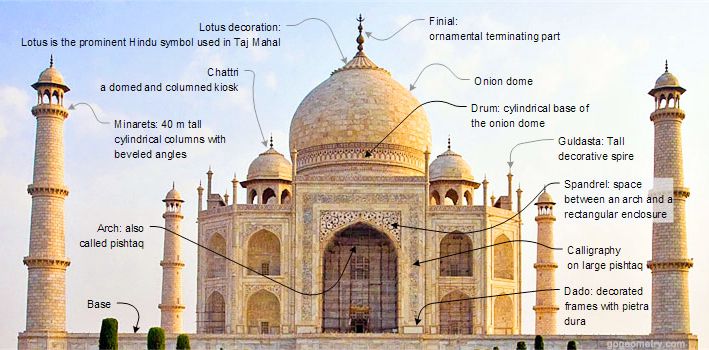Taj Mahal – A Hindu Temple (Part 3/6)


Most people content to see Mumtaz’s grave inside the Taj fail to go to the rear riverside. This is the riverside view. From here one may notice that the four-storied marble structure on top has below it two more stories in red stone. Note the window aperture in the arch at the left. That indicates that there are rooms inside. Inside the row of arches in the upper part of the wall are 22 rooms. In addition to the four stories in marble, this one shows red stone arches in the 5th storey. The 6th storey lies in the plinth in the lower portion of the photo. In another photo a doorway would be seen in the left corner of the plinth, indicating the presence of apartments inside, from where one could emerge on the river for a bath.

These corridors at the approach of the Taj Mahal are typically Hindu. They may be seen in any ancient Hindu capital. Note the two octagonal tower cupolas at the right and left top. Only Hindus have special names for the eight directions and celestial guards assigned to each. Any octagonal feature in historic buildings should convince the visitor of their Hindu origin. Guards, palanquin bearers and other attendants resided in hundreds of rooms along numerous such corridors when the Taj Mahal was a Hindu temple palace. Thus the Taj was more magnificent and majestic before it was reduced to a sombre Islamic cemetery.

This Naqqar Khana alias Music House in the Taj Mahal garden is an incongruity if the Taj Mahal were an Islamic tomb. Close by on the right is the building which Muslims claim to be a mosque. The proximity of a mosque to the Music House is incongruous with Muslim tradition. In India, Muslims have a tradition of pelting stones on Hindu music processions passing over a mosque. Moreover a mausoleum needs silence. A dead person’s repose is never to be disturbed. Who would then provide a band house for a dead Mumtaz? Contrarily Hindu temples and palaces have a music house because morning and evening Hindu chores begin to the sweet strains of sacred music.

Such are the rooms on the 1st floor of the marble structure of the Taj Mahal. The two staircases leading to this upper floor are kept locked and barred since Shahjahan’s time. The floor and the marble walls of such upper floor rooms can be seen in the picture to have been stripped of its marble panels. Shahjahan used that uprooted marble from the upper floor for constructing graves and engraving the Koran because he did not know wherefrom to procure marble matching the splendour of the rest of the Taj Mahal. He was also so stingy as not to want to spend much even on converting a robbed Hindu temple into an Islamic mausoleum.

Source: Stephen Knapp – Taj Mahal: Was it a Vedic Temple?
Part 4 https://kreately.in/taj-mahal-a-hindu-temple-part-4-6/
DISCLAIMER: The author is solely responsible for the views expressed in this article. The author carries the responsibility for citing and/or licensing of images utilized within the text.
